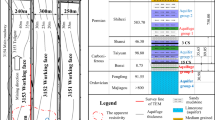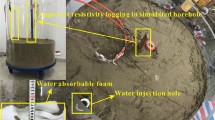Abstract
Mine water and mine inflow water are closely linked to the risk of mine water disasters. The relationships between various geophysical parameters and the volume of water in mine tunnels were considered by using an integrated suite of appropriate geophysical methods [i.e. direct current (DC) resistivity, transient electromagnetic method (TEM), and the seismic scattered wave method], and knowledge of the essential features of seam floor water in karst coal mine settings. By constructing a 3-dimensional physical simulation of water-bearing limestone, a quantitative predictive formula for water volume in abnormal bodies was derived in terms of the parameters of the selected suite of geophysical methods. Water volume was determined by using apparent resistivity (obtained from the DC resistivity survey and TEM), a measure of the amount of potentially water-containing space, and a correction coefficient. The quantitative formula was adjusted for accuracy using field data, and then tested at a specific field site. The average accuracy of predictions using the composite quantitative formula was 75.8 %, which is considered to be high. The formula presented in this paper could contribute significantly to the prevention and mitigation of water-related disasters in karst coal mines.
Zusammenfassung
Grubenwasservorkommen und –zuflüsse erhöhen oftmals das Risiko für mögliche Grubenunglücke. Durch die integrierte Anwendung geeigneter geophysikalischer Methoden (z. B. Gleichstrom (DC) Widerstandsverfahren, Transienten-Elektromagnetik-Methoden (TEM), Seismische-Streuwellen-Verfahren) wird die Beziehungen zwischen unterschiedlichen geophysikalischen Parametern und dem vorhanden Wasservolumen in Grubenhohlräumen untersucht. Einbezogen werden dabei auch die Vorkenntnisse über die Ausbildung von Liegendwasservorkommen in verkarsteten Hohlräumen unterhalb von Kohlebergwerken. Durch die Konstruktion einer 3-dimensionalen Modells des wasserführenden Kalksteins wird ein quantitativer Algorithmus für die Wasservolumenabschätzungen bzw. -vorhersagen entwickelt, wobei Parameter aus den angewendeten geophysikalischen Verfahren genutzt werden. Zur Bestimmung der Summe des potenziell wasserführenden Hohlraumes (Wasservolumens) werden die scheinbaren Widerstandswerte aus den DC-Anwendungen und den TEM-Messungen sowie weitere Korrektur-Koeffizienten verwendet. Die resultierende Formel wurde durch Felddaten überprüft und anhand von spezifischen Feldtests validiert. Die durchschnittliche Vorhersagegenauigkeit bei der Verwendung des Algorithmus lag bei (relativ hohen) 75,8 %. Die hier präsentierte Formel kann signifikant dazu beitragen, Schäden bzw. Unglücke durch Liegendwasserzutritte in verkarsteten Kohlebergwerken zu minimieren bzw. zu verhindern.
Resumen
El agua de mina y el agua que puede irrumpir en las minas están estrechamente vinculada a los riesgos de desastres de agua en las minas. Las relaciones entre varios parámetros geofísicos y el volumen de agua en los túneles de la mina fueron consideradas usando un juego integrado de métodos geofísicos apropiados (resistividad de corriente continua (DC), método del sondeo electromagnético transiente (TEM) y el método sísmico de dispersión de ondas) y el conocimiento de las características relevantes de las vetas de agua del piso en las minas de carbón. A través de una simulación física tridimensional de calizas con contenido de agua, se derivó una fórmula predictiva cuantitativa para el volumen de agua en cuerpos anormales en términos de los parámetros de los métodos geofísicos seleccionados. El volumen de agua fue determinado usando la resistividad aparente (obtenida a partir de TEM y DC), una medida de la cantidad de agua potencialmente contenida en el espacio y un coeficiente de corrección. La formula cuantitativa fue ajustada usando datos de campos y luego testeada en un sitio específico. La precisión promedio de las predicciones usando la formula cuantitativa fue 75,8 %, que es considerada alta. La formula presentada en este trabajo podría contribuir significativamente a la prevención y mitigación de los desastres vinculados con el agua en las minas de carbón.
摘要
矿井涌(突)水量与矿井水害威胁程度密切相关。基于综合物探原理(直流电法、瞬变电磁法和地震散射波法)和煤矿底板灰岩富水规律,研究了灰岩富水性与地球物理多场参数的关系。通过灰岩含水层三维相似物理模拟,建立了含水层水量与综合物探参数的定量关系,利用综合视电阻率(直流电法和瞬变电磁法)、潜在含水空间和校正系数来预测灰岩含水层水量。首先利用现场实测综合物探数据校正预测公式,然后进行现场试验验证,水量预测精度可达75.8 %。研究对煤矿灰岩水害防治具有重要意义。









Similar content being viewed by others
References
Benkabbour B, Toto EA, Fakir Y (2004) Using DC resistivity method to characterize the geometry and the salinity of the Plioquaternary consolidated coastal aquifer of the Mamora plain, Morocco. Environ Geol 45(4):518–526
Danielsen JE, Auken E, Jørgensen F, Søndergaard V, Sørensen KI (2003) The application of the transient electromagnetic method in hydrogeophysical surveys. J Appl Geophys 53(4):181–198
Dong S (2010) Some key scientific problems on water hazards frequently happened in China’s coal mines. J Chin Coal Soc 35(1):66–71 (in Chinese)
Dong S, Hu W (2007) Basic characteristics and main controlling factors of coal mine water hazard in China. Coal Geol Explor 35(5):34–38 (in Chinese)
Hu W (2013) Study orientation and present status of geological guarantee technologies to deep mine coal mining. Coal Sci Technol 41(8):1–5, 14 (in Chinese)
Jiang Z, Yue J, Yu J (2010) Experiment in metal disturbance during advanced detection using a transient electromagnetic method in coal mines. Min Sci Technol 20(6):861–863 (in Chinese)
Jin D, Liu Y, Liu Z, Cheng J (2013) New progress of study on major water inrush disaster prevention and control technology in coal mine. Coal Sci Technol 41(1):25–29 (in Chinese)
Lian H, Xia X, Xu B, Xu H, Yi S (2014) Evaluation and applicability study on prediction methods of water inflow in mines. J N China I Sci Technol 11(2):22–27 (in Chinese)
Liu S, Zhang P (2006) Signal acquisition method of electrode potential difference in the distributed paralleling intellective way. China Patent of Invention: zl200410014020.0
Liu S, Liu S, Wu R, Zhang P, Fan Y (2007) Network parallel electrical instrument and stationary electrical prospecting. China Sci Technol Achiev 7(24):31–36 (in Chinese)
Liu S, Yang S, Cao Y, Liu J (2010) Analysis about response of geoelectric field parameters to water inrush volume from coal seam roof. J Min Safety Eng 27(3):341–345 (in Chinese)
Liu J, Liu S, Cao Y, Yang S (2013) Quantitative study of geoelectric parameter response to groundwater seepage. Chin J Rock Mech Eng 32(5):986–993 (in Chinese)
Liu SD, Liu L, Yue J (2014) Development status and key problems of Chinese mining geophysical technology. J China Coal Soc 39(01):19–25 (in Chinese)
Wu Q (2014) Progress, problems and prospects of prevention and control technology of mine water and reutilization in China. J China Coal Soc 39(5):795–805 (in Chinese)
Wu Q, Cui F, Zhao S, Liu S, Ceng Y, Gu Y (2013) Type classification and main characteristics of mine water disasters. J China Coal Soc 38(4):561–565 (in Chinese)
Xu J, Liu S, Wang B, Zhang P, Gui H (2012) Electrical monitoring criterion for water flow in faults activated by mining. Mine Water Environ 31:172–178
Yang Y, Chen Y (2009) Chaotic characteristics and prediction for water inrush in mine. Earth Sci J China Univ Geosci 34(2):258–262 (in Chinese)
Yu J, Liu Z, Yue J, Liu S (2007a) Development and prospect of geophysical technology in deep mining. Prog Geophys 22(2):586–592 (in Chinese)
Yu J, Liu Z, Liu S, Tang J (2007b) Theoretical analysis of mine transient electromagnetic method and its application in detecting water burst structures in deep coal stope. J China Coal Soc 32(8):818–821 (in Chinese)
Yue J, Li Z (1997) Mine DC electrical methods and application to coal floor water invasion detecting. J China Univ Min Technol 26(1):94–98 (in Chinese)
Acknowledgments
We gratefully acknowledge financial support by the National Natural Science Foundation Projects, “Detecting Theory and Method of High Resolution Mine Seismic Detection” (Grant No. U1261202).
Author information
Authors and Affiliations
Corresponding author
Electronic supplementary material
Below is the link to the electronic supplementary material.
Supplemental Fig. 1
Physical model (TIFF 3677 kb)
Supplemental Fig. 2
Observation system arrangement for DC resistivity survey (PDF 32 kb)
Rights and permissions
About this article
Cite this article
Yang, C., Liu, S. & Wu, R. Quantitative Prediction of Water Volumes Within a Coal Mine Underlying Limestone Strata Using Geophysical Methods. Mine Water Environ 36, 51–58 (2017). https://doi.org/10.1007/s10230-016-0394-4
Received:
Accepted:
Published:
Issue Date:
DOI: https://doi.org/10.1007/s10230-016-0394-4




